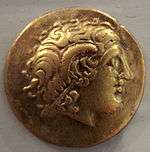Viducasses
The Viducasses were a Gallic tribe of Gallia Lugdunensis.

Name
They are mentioned as Viducasses by Pliny (1st c. AD),[1] and as Bidoukesíōn (Βιδουκεσίων; var. Βιδουκασίων, Βιδουκαίσιων) and Bidoukésioi (Βιδουκέσιοι; var. Οὐιδουκαίσιοι, Οὐιδουκέσιοι) by Ptolemy (2nd c. AD).[2][3]
The meaning of the name Viducasses is unclear. The prefix stems from Gaulish uidu- ('tree, wood'), but the translation of the element -casses is less certain, possibly 'hair, hairstyle', perhaps a particular warrior coiffure, or 'tin, bronze (helmet?)'.[4] From this interpretation, the meaning 'tangled-hair ones', 'those with the tangled hair (like a tree)' has been proposed.[5]
The city of Vieux, attested as Veiocae in 1180 (Vex in 1239, Vieux in 1294) is named after the Gallic tribe.[6]
Geography
The capital of the Viducasses was at Araegenus or Araegenue of the Tabula Peutingeriana, appearing elsewhere as Aragenuae, which was the site of modern-day Vieux.
History
Pliny (iv. 18) mentions them before the "Bodiocasses", who are supposed to be the Baiocasses. Ptolemy (ii. 8. § 5) writes the name Οὐιδουκαίσιοι or Οὐιδουκάσσιοι, for we must assume them to be the Viducasses, though he places the Viducassii next to the Osismii, and the Veneti between the Viducassii and the Lexovii. But the Viducasses are between the Baiocasses and the Lexovii. The boundary between the Viducasses and the Baiocasses is indicated by a name Fins (Fines), which often occurs in French geography.
Vieux lies southwest of Caen, in the department of Calvados, some distance from the left bank of the river Orne. This place is mentioned in the titles or muniments of the neighboring abbey of Fontenai, on the other side of the Orne, under the name of Videocae or Veocae, of which Vieux is a manifest corruption, as D'Anville shows, like Tricasses, Trecae, Troies, and Durocasses, Drocae, Dreux. There is or was a stone preserved in the château of Torigni, in the arrondissement of Saint Lô, in the department of Manche, which contains the inscription "ORDO CIVITATIS VIDVCAS". This marble, which was found at Vieux in 1580, is said to be the pedestal of a statue placed in the third century in honor of T. Sennius Solemnis. In the excavations made at Vieux in 1705 were found remains of public baths, of an aqueduct, a gymnasium, fragments of columns, of statues, and a great number of medals of the imperial period, besides other remains. Inscriptions, of the date 238, found on the spot show that this city had temples and altars erected to Diana, to Mars, and to Mercury. (Nouveaux Essais sur la Ville de Caen, par M. L'Abbé Delarue, 2 vols. Caen, 1842, cited by Richard et Hocquart, Guide du Voyageur) Remains show that it was a Roman city, probably built on a Celtic site; and several Roman roads branch off from it.
See also
References
- Pliny. Naturalis Historia, 4:107
- Ptolemy. Geōgraphikḕ Hyphḗgēsis, 2:8:2; 2:8:5
- Falileyev 2010, p. entry 1048.
- Delamarre 2003, pp. 109–110.
- Delamarre 2003, p. 109.
- Nègre 1990, p. 158.
Bibliography
- Delamarre, Xavier (2003). Dictionnaire de la langue gauloise: Une approche linguistique du vieux-celtique continental (in French). Errance. ISBN 9782877723695.CS1 maint: ref=harv (link)
- Falileyev, Alexander (2010). Dictionary of Continental Celtic Place-names: A Celtic Companion to the Barrington Atlas of the Greek and Roman World. CMCS. ISBN 978-0955718236.
- Nègre, Ernest (1990). Toponymie générale de la France (in French). Librairie Droz. ISBN 978-2-600-02883-7.CS1 maint: ref=harv (link)
![]()
External links
- Viducasses (French)
